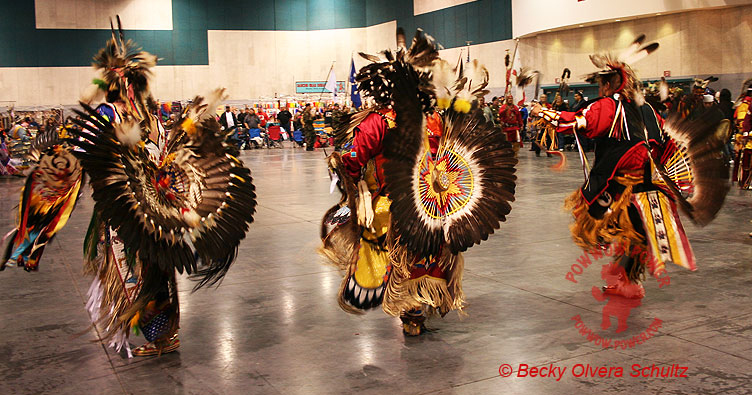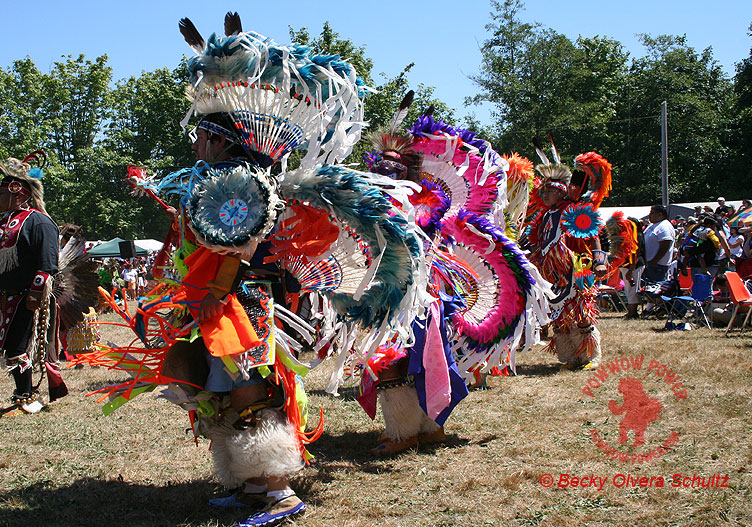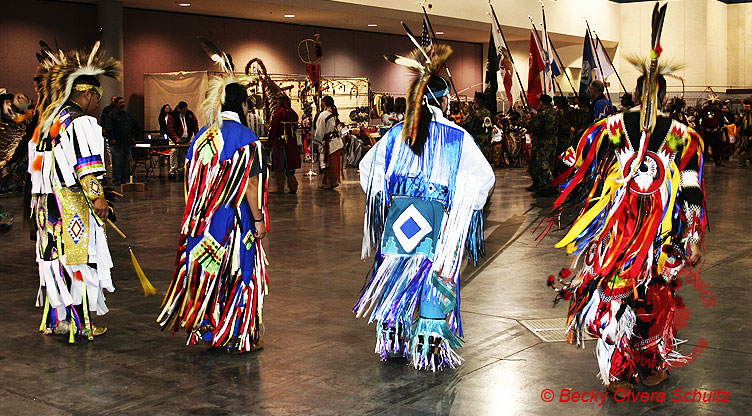Native American Powwow Male Dance Styles: Traditional, Fancy, Grass, Chicken and Hoop
Native American traditional men dancers wear a single bustle (usually eagle feathers, sometimes hawk or turkey) tied to the lower back of their outfits. Some wear bonnets made of feathers, but many wear a warrior’s hairpiece, which is called a roach. The roach is made from deer tail, porcupine or horsehair and has one or two eagle feathers in the center. They also carry weapons, feather fans, staffs, shields or other items that have special meaning to them. Because Native Americans lived so close to nature in the past, the Traditional dancer’s regalia reflect this relationship and dependence on nature by use of feathers, porcupine quills, shells, horsehair, skins (deer, ermine, otter, and wolf) as well as horn, teeth and bone. They honor the spirits of the animals that provide much of their dance clothing and treat their regalia with great care and respect. Adding to the dramatic effect of the Traditional outfit, many men paint their faces with designs that express their own personal vision that may have come from a dream or important experience (Ancona 1993:22).
Many Traditional dancers wear cloth or deerskin leggings and a breechcloth. Some go barelegged. Large brass bells are often worn around the ankles and moccasins that add to the stately effect of their dance steps (Braine 1995:20).
The men’s Traditional dance evolved from when warriors returned and danced out the story of a battle or a hunt (Braine 1995:20). The dance style of the Traditional men may imitate the movements of animals or birds. Some dance in a crouched position simulating tracking or hunting. Whatever the particular style, the Traditional men’s dance is impressive and dramatic (Ancona 1993:25).
The men’s Fancy dance is an energetic and fast style of dance, a dance of younger men. They spin, twist and use quick steps and fast turns making it a dance of strength and endurance. Their outfits are traditional but made of lots of bright colors, metallic beads, sequins and ribbons which all create a flashy display as they dance. They have two bustles instead of one, one at the shoulders and one at the lower back. In addition to the head roach, they also wear intricately beaded headbands with a large beaded medallion on the forehead (Ancona 1993:30-32).
The Fancy Dance evolved from the early Plains tribe’s war and victory dances. Buffalo Bill Cody exploited this dance by enlisting Indians to dance during his Wild West shows. Because of this connection to Buffalo Bill, the Fancy Dance was considered a “sellout” to the white man’s society and for some time was not acceptable to many Indians.
Grass dancers tend to say that their dance is the oldest style. Their movements imitate prairies chickens or other birds, dipping low to the ground and circling in a crouching posture (Braine 1995:24). The Grass Dance is said to have been based on the old war society dances of the northern plains Indians. This style is fast stepping with the dancer appearing to nearly fall off balance but catching himself in the nick of time. The regalia is much different, consisting of long colorful yarn fringe and ribbons hanging from the shoulders, waist, and legs. No bustle is worn. Like the Fancy dancers, they wear beautiful beaded headbands as well as a roach. They carry eagle feather fans, whips, wands and small hoops. As they dance the long fringe simulates the movement of the grasses of the prairie swaying in the wind (Ancona 1993:39).
The Chicken style dance is a special and old form of dancing. The Chicken dancers wear a very small bustle or no bustle at all. They wear roaches and some use piano wire to hang feather fluffs off their outfits that bounce when dancing. The style mimics a male prairie chicken during courting and is a fast dance. Some say it originates from the Blackfeet nation and began as a religious or spiritual society. One of the main stories says that a young Blackfeet man was hunting for his family, heard a thumping noise in the distance. When he followed the sound he saw prairie chickens in the tall grasses dancing. He killed one of the chickens and brought it back home to his wife to prepare for dinner. After dinner while the man was sleeping he dreamed that the prairie chicken spirit came to him. In the dream it asked why he had killed it because the chicken people were doing a sacred dance. The man of course said he killed because he needed to feed his family. Because the man answered honestly, the prairie chicken told the man he would teach him the sacred dance of the prairie chicken and this is how the Chicken Dance came to the Blackfeet people. This is considered a Special dance and not usually seen performed at powwows. It is most popular in the northwestern regions of the U.S. and in Canada and many believe it is a dance to heal loved ones and family.
The Hoop Dance is another special dance not always performed at powwows, but when performed it is a real treat and is often performed at special events and shows. It is said it was started in the 1930’s and many give credit to Tony White Cloud, a Jemez Pueblo native who was instrumental in its evolution when he began using multiple hoops in a stylized version. It is a storytelling dance where large colorful hoops are used to form animal shapes during the dance. Dance moves are very fast with the construction of hoop formations made around the body. Some Hoop dancers manipulate up to 30 or more hoops, creating various shapes. Hoops today are made of willow, bois d’arc, reed or plastic hose, all decorated with bright tape and paint. Many Hoop dancers mark four symbols on each hoop to represent the four seasons, the four directions and four sacred colors. Originally primarily a dance for men, some women also Hoop dance.





